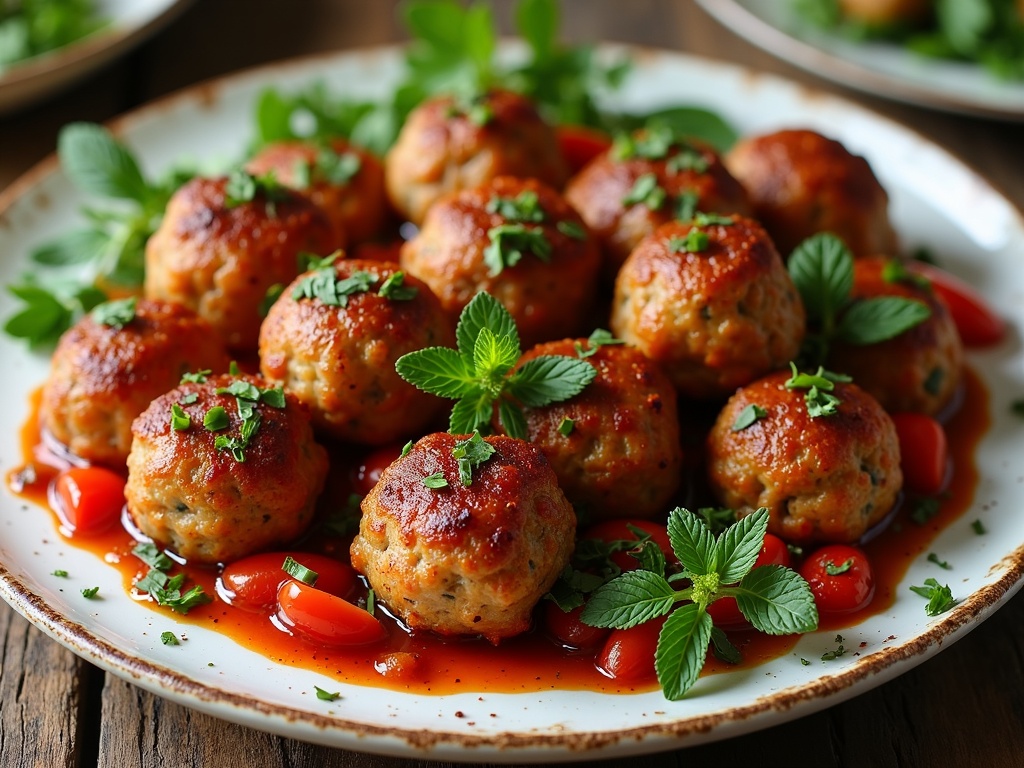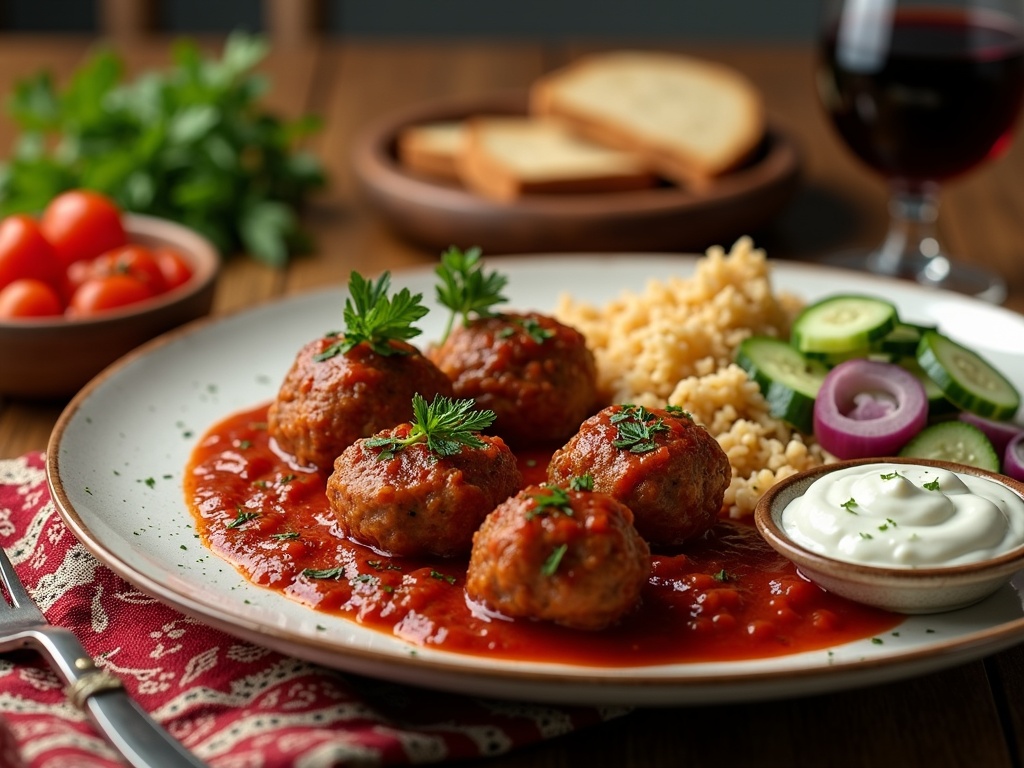Soutzoukakia, an iconic Greek dish with origins in Smyrna (modern-day Izmir, Turkey), represents a perfect fusion of Mediterranean culinary traditions featuring distinctive oval-shaped meatballs in rich tomato sauce. Distinguished by its unique spice profile that includes generous cumin, garlic, and cinnamon, this beloved comfort food traveled from Asia Minor to mainland Greece following population exchanges in the 1920s, becoming a treasured staple that reflects the resilience of Greek culinary heritage.
Find In This Article
Key Takeaways
- The dish’s distinctive flavor comes from its unique spice blend, particularly cumin and cinnamon, which sets it apart from other Greek dishes and reflects eastern Mediterranean influences.
- Traditional soutzoukakia preparation involves a two-stage cooking method: first browning the oval-shaped meatballs, then simmering them in a rich tomato sauce.
- Each Greek region has developed its own variation, with northern areas favoring lamb-beef combinations while island versions incorporate different local herbs and spices.
- In Greek households, soutzoukakia recipes are treasured family heirlooms passed through generations, serving as vehicles for cultural identity and tradition.
- Modern adaptations include healthier cooking methods like baking instead of frying, and alternative ingredients to accommodate dietary restrictions while preserving authentic flavors.
A Treasured Greek Dish with Deep Historical Roots
Soutzoukakia represents one of Greece’s most beloved culinary treasures, with roots that run surprisingly deep into Mediterranean history. I’ve found that understanding the journey of this dish adds an extra layer of appreciation when enjoying these savory meatballs in their rich tomato sauce.
The Journey from Smyrna to Modern Greek Tables
This dish originated in Smyrna (modern-day Izmir, Turkey) during the 19th century, where Greek communities thrived alongside other cultural influences. The recipe emerged as a perfect fusion of flavors that reflected the multicultural environment of this important port city. When I prepare traditional lamb meatballs like soutzoukakia, I’m participating in a culinary tradition that spans generations.
The Byzantine Empire’s culinary traditions heavily influenced soutzoukakia’s development, particularly in the spice combinations that make this dish so distinctive. The integration of cumin—unusual in many Greek dishes—points to eastern influences that set soutzoukakia apart from other Mediterranean kofta recipes.
Traditionally made from ground beef or seasoned lamb, these oval-shaped meatballs feature a flavor profile unlike anything else in Greek cuisine. The key distinctive elements include:
- Generous amounts of cumin, giving an earthy, warm undertone
- Fresh garlic, typically used in abundance
- Red grape juice (substituting for traditional wine)
- A hint of cinnamon that balances the savory elements
- Fresh herbs like mint or parsley
After the Greek War of Independence, soutzoukakia gained even more significance in mainland Greek cuisine, particularly following the population exchanges of the 1920s when Greeks from Asia Minor brought their culinary traditions to the mainland. The dish quickly became integrated into the broader Greek culinary landscape, though regional variations developed across different parts of the country.
I’ve discovered that the tomato sauce component—rich, aromatic, and slightly sweet—is just as important as the meatballs themselves. Modern versions sometimes incorporate slow-cooked techniques similar to those used in beef ragu, allowing the flavors to develop more fully.
Today, soutzoukakia remains a staple in Greek households and restaurants, served typically with rice or crispy potatoes to soak up the delicious sauce. Its journey from Smyrna to becoming a treasured family recipe throughout Greece reflects the resilience and adaptability of culinary traditions through history.
Crafting the Perfect Soutzoukakia
Soutzoukakia represents the beautiful marriage of Greek and Turkish culinary traditions. I’ve spent years perfecting this dish, and the secret lies in balancing the aromatic spices with the right meat-to-onion ratio. These oblong-shaped meatballs gain their distinctive character from the warm spices and rich tomato sauce they’re simmered in.
The Essential Ingredients
The foundation of excellent soutzoukakia starts with quality ground meat. I use 2 pounds of ground beef with about 15-20% fat content for the best flavor and texture. The meat needs proper seasoning, and this is where the magic happens. One large finely chopped onion and 3 minced garlic cloves provide the aromatic base.
The spice blend is what truly sets soutzoukakia apart from other Mediterranean meatball recipes. I mix in 1 teaspoon of cumin, which gives the dish its distinctive earthy flavor. Cinnamon and allspice add warmth and complexity that’s characteristic of eastern Mediterranean cuisine. These spices create a flavor profile similar to traditional Middle Eastern kofta but with a unique Greek twist.
For an interesting textural element, I sometimes add ½ cup of uncooked rice to the meat mixture. As it cooks, the rice expands slightly, creating little pockets of texture throughout each meatball. This addition also helps stretch the meat further, making the dish more economical without sacrificing flavor.
The Two-Stage Cooking Method
What makes soutzoukakia stand out from other hearty meat dishes is the two-step cooking process that develops complex flavors and perfect texture.
First, I shape the meat mixture into oval-shaped meatballs, slightly flattened and about 2-3 inches long. Unlike round meatballs found in various global recipes, this elongated shape is traditional and allows for better sauce absorption.
The initial frying stage is crucial for developing a flavorful crust. I heat olive oil in a large skillet and carefully brown the meatballs on all sides. This step creates a barrier that helps the meatballs maintain their shape while adding a delicious caramelized flavor.
The second stage involves simmering the meatballs in a rich tomato sauce. I prepare about 2 cups of sauce using tomato paste, crushed tomatoes, a touch of red wine, and additional spices. The meatballs gently cook in this sauce for about 20-30 minutes, absorbing the flavors while remaining tender.
This method bears similarities to Italian polpette, which also employs the technique of simmering meatballs in sauce. Swedish köttbullar follows a comparable approach but uses a cream-based sauce instead. The slow simmering technique allows the spices to fully bloom and infuse the sauce with the meat’s flavors.
The resulting dish offers tender, aromatic meatballs bathed in a rich, slightly sweet tomato sauce that’s perfect for sopping up with bread or serving over rice. The flavors continue to develop, making soutzoukakia even better the next day.
For an authentic experience, I serve soutzoukakia with a side of creamy mashed potatoes or fluffy rice, similar to how you might serve a flavorful curry with rice. A sprinkle of fresh parsley and a squeeze of lemon just before serving brightens the entire dish and cuts through the richness of the sauce.
The Complete Dining Experience
Soutzoukakia offers more than just incredible flavor—it creates an entire culinary experience when paired with the right accompaniments. I’ve found that serving these Greek meatballs with simple sides allows their rich, aromatic qualities to shine while creating a satisfying meal.
Perfect Pairings and Sides
Traditional Greek households typically serve soutzoukakia over a bed of fluffy rice, which absorbs the tomato sauce beautifully. Alternatively, a basket of crusty bread works wonderfully for sopping up every last bit of the savory sauce. When hosting dinner parties, I’ve noticed guests appreciate having both options available.
For a complete meal, I recommend these complementary sides:
- Creamy tzatziki sauce provides a cooling contrast to the warm spices
- A simple Greek salad with cucumber, tomato, red onion, and feta cheese
- Roasted vegetables like zucchini, eggplant, and bell peppers
- Lemon-dressed greens for a bright, acidic balance
A standard recipe yields enough to serve 4-6 people generously, making it perfect for family dinners or small gatherings. For presentation, I sprinkle fresh herbs like parsley or mint over the meatballs and add a touch of lemon zest to brighten the dish.
Nutritional Benefits and Wine Pairing
Each serving of soutzoukakia (approximately 4 meatballs) contains 350-400 calories, making it a reasonably moderate main course. The dish is protein-rich, providing 20-25 grams per serving—excellent for muscle maintenance and satiety. When accompanied by vegetables, it delivers a good dose of iron and dietary fiber, creating nutritional balance.
For wine enthusiasts, I recommend pairing soutzoukakia with a robust Greek red wine like Agiorgitiko. This varietal’s medium body and notes of red fruits complement the tomato sauce while standing up to the spices. The wine’s moderate tannins help cut through the richness of the meat, creating a delightful balance.
The combination of flavors in soutzoukakia shares similarities with other Mediterranean classics like traditional kofta or spiced lamb dishes. What makes soutzoukakia unique is the distinctive cumin-cinnamon spice blend and the rich tomato sauce that transforms simple meatballs into something truly special.
A Symbol of Greek Heritage
Soutzoukakia has carved its place in Greek culture far beyond being just another delicious dish. I’ve found that these flavorful, aromatic meatballs represent something much deeper in Greek society – they’re vessels of history, family connections, and cultural identity.
Family Traditions and Generational Recipes
In Greek households, soutzoukakia recipes are precious heirlooms passed down through generations. Each family guards their unique version, with slight variations in spices and cooking techniques making every household’s soutzoukakia distinctly their own. Grandmothers teach daughters and granddaughters the precise method of shaping the oblong meatballs, while sharing stories of their own childhood. This practice mirrors similar traditions found in other meat dishes like traditional Middle Eastern kofta, where recipes become family treasures.
The preparation of soutzoukakia often becomes a communal activity, bringing multiple generations together in the kitchen. Children learn to mix the meat with cumin, garlic, and other spices, while elders oversee the simmering of the tomato sauce. These cooking sessions strengthen family bonds and ensure cultural continuity.
Cultural Celebrations and Identity
Soutzoukakia plays a central role in Greek celebrations and festivals throughout the year. During Easter feasts, nameday celebrations, and village festivals, these savory meatballs frequently appear as a beloved main course. The dish shares the spotlight with other festive foods like rich lamb dishes that feature prominently in Mediterranean celebrations.
For Greek diaspora communities worldwide, soutzoukakia serves as a powerful connection to their homeland. In places like Australia, America, and Canada, Greek immigrant families prepare this dish to:
- Maintain cultural connections across oceans
- Introduce Greek culinary heritage to new generations born abroad
- Create a sense of “home” through familiar flavors and aromas
- Build community through shared meals with fellow Greeks
The distinctive flavor profile of soutzoukakia, with its characteristic cumin and tomato sauce, instantly transports Greek expatriates back to their homeland. Much like hearty beef curry for South Asian communities abroad, soutzoukakia helps preserve cultural identity in new environments.
When Greek cultural festivals occur in diaspora communities, soutzoukakia frequently features on menus alongside other iconic dishes. The preparation often follows traditional methods, sometimes adapting to include locally available ingredients while maintaining authentic flavor profiles.

Regional Variations and Modern Adaptations
Soutzoukakia has evolved differently across Greece, with each region putting its unique stamp on this beloved meatball dish. I’ve noticed that while the Smyrna-style remains the classic version, creative adaptations continue to emerge, keeping this traditional favorite relevant in modern cooking.
Diverse Meat and Flavor Profiles
The foundation of soutzoukakia varies significantly by region and family tradition. In northern Greece, many recipes favor a mixture of lamb and beef combinations for a richer flavor profile, while island versions might incorporate more aromatics. Some coastal areas even blend small amounts of fish into their meat mixture for an unexpected umami boost.
The herb combinations also showcase regional preferences:
- Peloponnese versions often include abundant fresh parsley and mint
- Island variations might incorporate wild oregano and thyme
- In Macedonia, some recipes feature subtle hints of dill alongside the traditional cumin
Spice blends tell a story of local influence as well. While cumin remains the signature flavor in most versions, Cretan soutzoukakia often includes more cinnamon and allspice, creating a warmer profile. Eastern Greek islands sometimes incorporate subtle Middle Eastern influences with kofta-inspired spicing that includes more paprika and even a hint of sumac.
Contemporary Twists and Dietary Adaptations
Modern cooking has embraced soutzoukakia while adapting it for today’s dietary needs. Many contemporary home cooks have moved away from the traditional deep-frying method, opting instead for baking or pan-searing with minimal oil. This preserves the beloved flavor while creating a lighter dish that fits into health-conscious meal plans.
I’ve seen creative beef-based variations that substitute traditional wheat-based breadcrumbs with alternatives like:
- Ground oats for added fiber and a slightly nuttier taste
- Almond meal creating a protein-rich, gluten-free option
- Soaked bulgur wheat providing authentic texture with reduced refined carbs
The sauce has also evolved beyond the classic tomato base. Some newer interpretations incorporate roasted red peppers for sweetness, while others introduce curry-inspired elements with turmeric and ginger. For those avoiding nightshades, creative chefs have developed alternatives using pumpkin or carrot purees as the sauce base.
The evolution of soutzoukakia demonstrates how traditional recipes can maintain their cultural significance while adapting to contemporary tastes and dietary needs. Whether enjoying a classic version or experimenting with lamb kofta-inspired variations, these flavorful meatballs continue to bring Mediterranean magic to dinner tables worldwide.

Sources:
An A-Z of Greek Food by G. P. Papadopoulos
Culinary Traditions of Greece: A Historical Cookbook by Elena K. Katsou
Greek Cooking: A Culinary Journey Through Greece by Peter K. Eleftheriou

